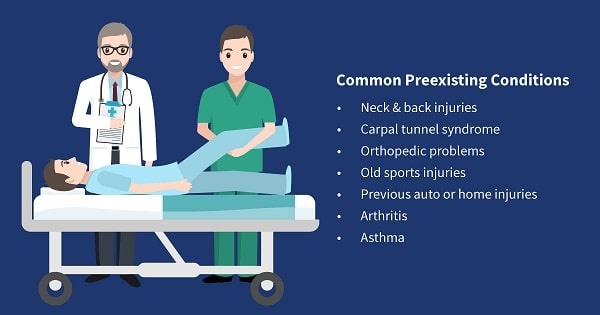No matter how safe an environment, a workplace injury can happen in any industry, at any time. If an employee is hurt on the job, the hours and days following the injury are critical when it comes to handling a workers’ comp claim.
While most employees are familiar with the concept of
workers’ compensation, some may not realize the importance of disclosing a preexisting injury or medical condition when filing a claim.

When an employee is clear and upfront about a preexisting condition, both the employer and employee stand to benefit. The employee receives the best possible treatment along with equitable compensation, while the employer is more likely to have the employee back and contributing to the organization sooner.
What Qualifies as a Preexisting Condition?
Workers’ compensation law defines a preexisting condition as a previous medical condition or the worsening of a preexisting injury. In the work comp world, the term refers to a medical condition or injury that predates the injury or condition for which the employee is making a claim.

Examples of common preexisting conditions include:
- A neck or back injury such as a herniated disc or fracture
- Carpal tunnel syndrome
- Arthritis
- Strains and sprains
- Orthopedic problems
- An old sports injury such as an ACL tear, tennis elbow (epicondylitis), shoulder dislocation or concussion
- A previous injury from an auto or home accident
- Asthma
Determining Coverage Eligibility
In most states, an injured worker is eligible for workers’ comp benefits when a work-related injury exacerbates a preexisting injury or condition – or leads to another condition. The kind of workers’ comp coverage and benefits an injured employee would qualify for varies heavily depending on the origin of the preexisting condition.
Generally, if the preexisting condition was caused by a previous work-related injury for which the employee is receiving workers’ compensation, the employee would qualify for additional workers’ compensation. The key is that the injury must have aggravated the condition – even if the preexisting condition was not work related.
A few examples of scenarios illustrating non-work-related preexisting conditions:
- Bob strains his lower back from a workplace fall, irritating a back injury that happened last fall while he was moving furniture at his home.
- Rachael, a former collegiate basketball player, tore her ACL during a tournament game five years ago. Now a paramedic, Rachael reinjures her surgically repaired ACL during a work training exercise.
- Joe, who has asthma, experiences a severe asthma attack while working in an unsanitary industrial plant.
If the employee’s preexisting condition is unrelated to his or her work – as illustrated in the scenarios above – the worker would need to file a separate claim, which would cover only the new work-related injury. It’s important to note that in cases like these, an injured employee would likely receive workers’ comp benefits to account for only the worsening of the medical condition caused by the new work-related injury.
Coverage Exclusions
While workers’ comp covers the majority of work-related injuries – employer costs for workers’ compensation amounted to more than
$96.5 billion in 2016 – there are exclusions. Non-work-related injuries, workplace injuries caused by horseplay and injuries sustained outside the scope of regular job duties are generally not covered, regardless of preexisting conditions.

Because the hours and days after a workplace injury are critical, every team leader in your organization should have access to a
comprehensive workers’ compensation checklist. Being prepared will help ensure the best outcome for everyone involved.
Leading the Way in Workers’ Comp
Standing behind small and mid-sized businesses, AmTrust understands the risks and challenges they face. As the nation’s top carrier in the small workers’ comp market, our company supports over
400 classes of business. As your risk management partner, we can customize a coverage plan to meet the specific needs of your business and your employees.
Contact us today to learn more.
This material is for informational purposes only and is not legal or business advice. Neither AmTrust Financial Services, Inc. nor any of its subsidiaries or affiliates represents or warrants that the information contained herein is appropriate or suitable for any specific business or legal purpose. Readers seeking resolution of specific questions should consult their business and/or legal advisors. Coverages may vary by location. Contact your local RSM for more information.